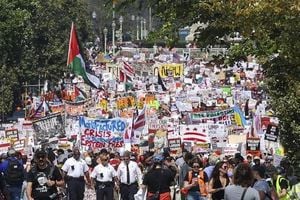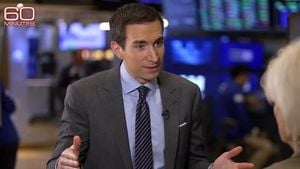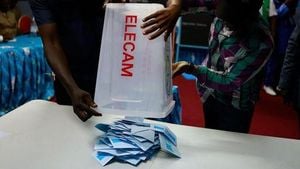On August 25, 2025, President Donald Trump once again thrust the debate over federal intervention in local crime into the national spotlight. In a series of remarks and executive actions, Trump claimed that America’s most crime-ridden cities are almost exclusively overseen by Democratic leaders, while sidestepping evidence that high rates of violent crime are far from a partisan phenomenon. His comments, coupled with a new executive order targeting cashless bail policies and the prospect of sending National Guard troops into Democratic strongholds, have reignited fierce debate about who is responsible for public safety—and what role, if any, the federal government should play.
"Sure, but there aren’t that many of them," Trump said Monday when asked if he would consider deploying National Guard troops to Republican-led cities grappling with high crime. "If you look at the top twenty-five cities for crime, just about every one of those cities is run by Democrats." According to Newsweek, however, the picture is less clear-cut. Their recent list of the 30 U.S. cities with the highest number of violent crimes—focusing on cities with at least 100,000 residents—shows that 16 of those cities are in states that reliably vote Republican, including Tennessee, Ohio, Arkansas, Texas, South Carolina, Missouri, Utah, Oklahoma, and Louisiana.
Ohio, a state that has gone red in recent presidential elections, stands out with four cities—Cleveland, Toledo, Dayton, and Akron—appearing on the high-crime list. Yet Trump’s attention remains fixed on Chicago, Illinois, a city with a long history of Democratic leadership and a frequent target of Republican criticism. Illinois Governor JB Pritzker, himself a Democrat, has not shied away from pushing back against what he sees as political intimidation. According to Newsweek, Pritzker has been a vocal critic of Trump’s efforts to single out Chicago for federal intervention, even as other states with higher numbers of violent cities escape similar scrutiny.
Digging deeper, Newsweek found that 22 out of the 30 cities with the highest violent crime rates are led by Democratic mayors. While this fact is often cited by critics of Democratic urban governance, it’s also true that the underlying causes of violent crime—particularly gun violence—are shaped by state and federal policies as much as by local leadership. Funding for public safety initiatives, community violence intervention programs, and gun control laws all play a role, and these are frequently the domain of state legislatures and Congress.
This tension between federal and local authority was on full display in New York City on Monday. As Trump signed an executive order aimed at overhauling cashless bail—a policy he blames for releasing repeat offenders back onto the streets—top officials from the New York City Police Department (NYPD) met with Attorney General Pam Bondi at the department’s headquarters in Manhattan. Police Commissioner Jessica Tisch and other members of the NYPD executive team described the meeting as a "standard meet and greet," emphasizing that it had been scheduled before the latest round of executive actions from the White House. "NYPD is obviously the largest police department in the country. We should have a good working relationship with our partners in D.C., so it is very much a standard meet-and-greet," an NYPD spokesperson told the Washington Examiner.
Still, the timing of the meeting was impossible to ignore. Trump’s executive order, which specifically referenced cases of repeat offenders released on cashless bail in New York, came just hours before the NYPD’s sit-down with Bondi. The White House published an article highlighting these cases, using them as justification for federal intervention. Trump has repeatedly floated the idea of sending National Guard troops or other federal law enforcement agencies into New York City, arguing that local leaders are failing to keep residents safe.
New York’s top officials have not taken kindly to the suggestion. Mayor Eric Adams and Governor Kathy Hochul both issued public statements rejecting the notion that federal troops are needed to restore order. "We’ve got this," Hochul told Katie Couric, echoing Adams’ comments to CBS New York. Their message was clear: New York’s leaders believe they are capable of managing their own affairs without Washington’s heavy hand.
The same debate is playing out in cities across the country. Four of the red states highlighted by Newsweek—states that have sent National Guard troops to Washington D.C. in the past—are home to cities with some of the nation’s highest rates of violent crime. Yet, as Newsweek notes, the nation’s capital itself did not appear on the list of the most crime-ridden cities. This fact undercuts the narrative that crime is strictly a blue-state or blue-city problem, and raises questions about the consistency of federal intervention.
Perhaps most striking is the Trump administration’s recent decision to cut $158 million in federal grants for community violence intervention programs. Earlier this year, the Department of Justice terminated 69 out of 145 such grants, despite widespread agreement among public safety experts that these programs play a crucial role in reducing violent crime. The move has drawn criticism from advocates who argue that slashing funding for proven interventions while calling for military deployments sends a mixed message about the administration’s true priorities.
At the heart of the debate is a fundamental disagreement about the causes of violent crime and the best path forward. Supporters of federal intervention argue that local leaders, particularly in Democratic-run cities, have failed to address surging violence. They point to statistics showing high rates of violent crime in cities like Chicago and New York, and argue that extraordinary measures are needed to protect residents. Opponents, meanwhile, counter that crime is a complex, nationwide challenge that cannot be solved by political grandstanding or by deploying troops. They emphasize the importance of addressing root causes—such as poverty, lack of opportunity, and the easy availability of firearms—while also supporting local police and community-based solutions.
As the political battle intensifies, the voices of those most affected by violence risk being drowned out by partisan bickering. City officials, police leaders, and community advocates alike are calling for a more nuanced, collaborative approach—one that recognizes the limits of both local and federal power, and prioritizes evidence-based strategies over rhetoric. Whether that vision can prevail in an election year remains to be seen, but the stakes for America’s cities could hardly be higher.
With both sides digging in and the rhetoric heating up, the nation is left to grapple with the age-old question: who truly bears responsibility for public safety, and at what cost?




